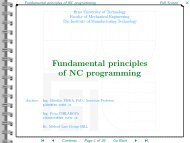Die & Mould Making - CNC - Computer Numerical Control
Die & Mould Making - CNC - Computer Numerical Control
Die & Mould Making - CNC - Computer Numerical Control
Create successful ePaper yourself
Turn your PDF publications into a flip-book with our unique Google optimized e-Paper software.
Grey cast-iron<br />
There is a large range of grey cast-irons<br />
with varying tensile strengths. The silicon<br />
content/sectional area combinations form<br />
various structures of which the low-silicon,<br />
fine graphite and pearlite make the<br />
strongest and toughest material. Tensile<br />
strength varies considerably throughout<br />
the range. A coarse graphite structure<br />
means a weaker type. A typical cast-iron,<br />
where metal cutting is involved, often has<br />
a silicon content of around 2%. Common<br />
are the austenitic types.<br />
Nodular cast-iron (SG)<br />
The graphite is contained as round nodules.<br />
Magnesium especially is used to deposit<br />
the gobules and added to become a magnesium-nickel<br />
alloy. Tensile strength, toughness<br />
and ductility are considerably improved.<br />
Ferritic, pearlitic and martensitic<br />
types with various tensile strengths occur.<br />
The SG cast-iron is also a graphite structure<br />
with properties in-between that of grey<br />
and nodular cast-iron. The graphite flakes<br />
are compacted into short ones with round<br />
ends through the addition of titanium and<br />
other treatment.<br />
Malleable cast-iron<br />
When white iron is heat treated in a particular<br />
way, ferritic, pearlitic or martensitic<br />
malleable cast-iron is formed. The heat<br />
treatments may turn the cementite into<br />
spherical carbon particles or remove the<br />
carbides. The cast-iron product is malleable,<br />
ductile and very strong. The silicon<br />
content is low. Three categories occur:<br />
ferritic, pearlitic and martensitic and they<br />
may also be categorized as Blackheart,<br />
Whiteheart and pearlitic.<br />
Alloyed cast-iron<br />
These are cast-irons containing larger<br />
amounts of alloying elements and, generally,<br />
these have similar effects on properties of<br />
cast-iron as they do on steel. Alloying elements<br />
are used to improve properties by<br />
affecting structures. Nickel, chromium,<br />
molybdenum, vanadium and copper are<br />
common ones. The graphite-free white<br />
cast-iron is extremely wear resistant while<br />
the graphite-containing cast-iron is also<br />
known as heat resistant ductile cast-iron.<br />
Corrosion resistance is also improved in<br />
some types. Toughness, hardness and heat<br />
resistance are typically improved.<br />
The main difference in these types is the<br />
form in which carbon, mainly graphite<br />
occurs.<br />
The general relative machinability of the<br />
four main kinds of cast-iron is indicated in<br />
a diagram where (A) is grey cast-iron, (B)<br />
malleable, (C) S.G. iron and (D) chilled,<br />
white cast-iron.<br />
100<br />
90<br />
80<br />
70<br />
60<br />
50<br />
40<br />
30<br />
20<br />
10<br />
0<br />
A B C D<br />
Relative machinability<br />
9



